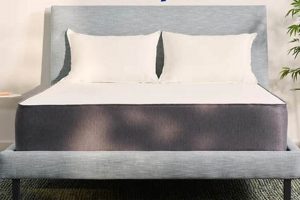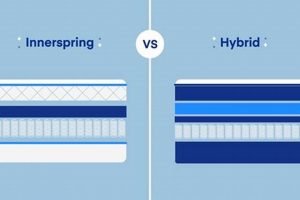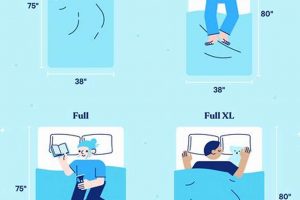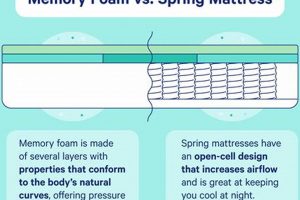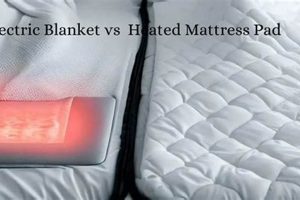The realm of sleep surfaces presents diverse options, each designed to cater to specific needs and preferences. Two prominent contenders in this market are all-foam constructions utilizing viscoelastic foam and those combining foam layers with an innerspring system. The former is characterized by its conforming properties, contouring closely to the body and distributing weight evenly. The latter aims to provide a balance of support and comfort through the integration of coils and various foam types.
Selecting a suitable sleep surface is a crucial decision, impacting sleep quality and overall well-being. A mattress that adequately supports spinal alignment and minimizes pressure points contributes to restful sleep and reduces the likelihood of discomfort. Historically, innerspring mattresses dominated the market, but advancements in foam technology have led to an increase in the popularity of all-foam designs and blended constructions.
The following discussion will delve into the distinct characteristics of each design, outlining their respective advantages and disadvantages. This analysis aims to equip individuals with the knowledge necessary to make an informed decision based on their individual needs, sleeping styles, and budgetary considerations. Key factors to consider include motion isolation, temperature regulation, edge support, and overall durability.
Selection Guidance
The selection of a sleep surface requires careful consideration of individual requirements. This section presents guidance to assist in the decision-making process.
Tip 1: Consider Sleeping Position: Individuals who sleep on their side may benefit from the pressure relief offered by all-foam construction, particularly in the shoulder and hip areas. Back sleepers may find the firmer support of a blended construction more suitable for maintaining spinal alignment. Stomach sleepers typically require a firm surface to prevent excessive sinking.
Tip 2: Assess Body Weight: Heavier individuals generally require a firmer mattress with robust support to prevent sagging and maintain proper spinal alignment. Lighter individuals may find softer surfaces more comfortable, allowing for better contouring and pressure relief.
Tip 3: Evaluate Temperature Sensitivity: Viscoelastic foam is known for its heat retention properties. Individuals who tend to sleep hot should consider designs incorporating cooling technologies such as gel-infused foam or breathable covers. Blended constructions with innerspring systems often promote better airflow than all-foam designs.
Tip 4: Evaluate Motion Isolation: If sharing a bed, motion isolation is an important factor to consider. All-foam designs typically excel at minimizing motion transfer, while blended constructions may exhibit more motion transfer depending on the coil system used.
Tip 5: Prioritize Edge Support: Strong edge support is beneficial for individuals who sit on the edge of the bed or require assistance getting in and out of bed. Blended constructions with reinforced edges often provide superior edge support compared to all-foam designs.
Tip 6: Compare Budget and Longevity: Prices can vary significantly depending on materials and construction. While blended constructions may have a slightly longer lifespan on average, the quality of materials and construction significantly influence the overall durability of any sleep surface.
Consideration of these aspects enhances the probability of selecting a sleep surface that optimizes comfort and provides effective support. The final choice should reflect a balance between individual needs, preferences, and budgetary constraints.
Following these guidelines prepares one for a deeper understanding of product specifications and informs the upcoming section on comparative analysis.
1. Conforming
Conforming, in the context of sleep surfaces, refers to the ability of a mattress to mold to the shape of the body. This characteristic is particularly pronounced in mattresses constructed primarily of viscoelastic foam, commonly known as “memory foam”. The degree to which a mattress conforms directly impacts pressure relief and spinal alignment. When pressure is evenly distributed across the sleep surface, concentrated pressure points on areas like the hips and shoulders are minimized. Proper spinal alignment is supported when the mattress fills the natural contours of the body, preventing unnatural twisting or bending during sleep. Conversely, mattresses with limited conforming capabilities may create pressure points and force the spine into misaligned positions, potentially resulting in discomfort or pain. The viscoelastic nature of memory foam allows it to slowly compress and adapt to the sleeper’s shape, creating a personalized support system.
In comparing all-foam and blended constructions, the level of conforming typically differs significantly. In a all-foam construction, the memory foam layer is the primary driver of this conforming effect. Hybrid designs, while also incorporating foam layers, often use innerspring systems as the core support structure. The coils in these systems may limit the extent to which the foam layers can contour to the body. However, the specific combination of foam types and coil design in a hybrid mattress can influence its conforming properties. For instance, a hybrid featuring a thick layer of memory foam combined with individually pocketed coils may offer a balance between conforming comfort and underlying support. In practical terms, an individual with chronic back pain may find more relief from an all-foam mattress due to its enhanced conforming ability, while another individual seeking a more supportive and responsive feel might prefer a hybrid design.
The emphasis on conforming highlights a key differentiator between various mattress designs. Though conforming is often associated with pressure relief and comfort, the ideal degree of conforming depends on individual preferences and sleep needs. While all-foam mattresses generally excel in this category, hybrid options are increasingly designed to offer a balance between conforming and support, broadening the range of choices available to consumers. The practical significance of understanding conforming lies in its direct impact on sleep quality and potential long-term musculoskeletal health. Individuals are therefore encouraged to carefully evaluate their unique needs and consider trialing different mattress types to determine the optimal level of conforming for their individual circumstances.
2. Support
Support, in the context of sleep surfaces, directly influences spinal alignment and overall comfort. Variations in support characteristics between all-foam and blended designs impact the quality of rest and potential musculoskeletal health.
- Core Structure and Stability
An all-foam construction derives support from high-density foam layers, engineered to resist compression and maintain a level sleeping surface. Blended designs, conversely, primarily rely on an innerspring system as the central support mechanism. The gauge and configuration of the coils dictate the firmness and responsiveness of the mattress. For example, a higher coil count typically translates to greater stability and reduced motion transfer, while a lower gauge (thicker) coil provides firmer support. This difference in core structure has implications for heavier individuals, who may require the robust support of an innerspring system to prevent excessive sagging.
- Edge Reinforcement and Perimeter Support
Edge support refers to the stability and resistance to compression along the perimeter of the sleep surface. All-foam designs often lack the robust edge support found in blended constructions with reinforced edges. Innerspring systems can be further enhanced with features such as encasement coils or foam rails, providing a more stable edge for sitting or sleeping near the perimeter. Compromised edge support can lead to a feeling of roll-off and reduce the usable sleep surface area. For example, individuals with mobility issues who rely on the edge of the bed for support when getting in and out may find blended constructions with enhanced edge support more suitable.
- Zoned Support Systems
Zoned support systems are designed to provide targeted support to different areas of the body, typically the lumbar region. Both all-foam and blended designs can incorporate zoned support through variations in foam density, coil configuration, or the addition of specialized support layers. The objective is to promote proper spinal alignment by providing firmer support to the midsection while allowing for more conforming comfort in the shoulder and hip areas. For example, a mattress with a firmer center zone can help prevent the pelvis from sinking too far, maintaining a more neutral spinal posture, particularly for back sleepers.
- Long-Term Sag Resistance
The ability of a mattress to maintain its shape and support characteristics over time is a crucial factor in its overall value. All-foam constructions are susceptible to body impressions and sagging, particularly if constructed with lower-density foams. Innerspring systems, while generally more resilient to sagging, can also exhibit coil fatigue or breakdown over time. The quality of materials and construction significantly influences the long-term sag resistance of both mattress types. For example, a blended construction utilizing high-quality steel coils and durable foam layers is likely to maintain its support characteristics longer than an all-foam mattress made with lower-density, less resilient materials.
In summary, support is a multifaceted characteristic that hinges on the core structure, edge reinforcement, zoned systems, and long-term sag resistance of a sleep surface. Comparing and contrasting how all-foam and blended constructions address these facets illustrates the fundamental differences between these mattress types. The choice of mattress should reflect an individual’s specific support needs, taking into consideration factors such as body weight, sleeping position, and any pre-existing musculoskeletal conditions. Further research into the specific materials and construction techniques used in each mattress design is recommended to make an informed purchasing decision.
3. Temperature
Temperature regulation is a significant factor influencing sleep quality. The materials and construction of a mattress directly impact its ability to dissipate heat and maintain a comfortable sleeping environment. The differences in thermal properties between all-foam and blended designs necessitate careful consideration based on individual temperature sensitivities.
- Material Composition and Airflow
Viscoelastic foam, due to its dense structure, tends to retain heat. This is because air circulation is restricted within the material, impeding the dissipation of body heat. Conversely, blended designs incorporating innerspring systems typically offer superior airflow. The open spaces between the coils allow for greater ventilation, facilitating the removal of heat and moisture. For instance, a individual who experiences night sweats may find a hybrid mattress more comfortable due to its improved breathability.
- Cooling Technologies and Innovations
Manufacturers have introduced various cooling technologies to address the heat retention issues associated with memory foam. Gel-infused foam aims to absorb and dissipate heat, while open-cell foam structures promote better airflow compared to traditional memory foam. Phase change materials (PCMs) can also be incorporated to regulate temperature by absorbing and releasing heat as needed. Such innovations seek to mitigate the thermal disadvantages of all-foam constructions. However, the effectiveness of these technologies can vary depending on the specific materials and construction techniques used. For example, a mattress incorporating a thick layer of gel-infused foam may provide some cooling benefits, but the underlying dense foam structure may still restrict airflow.
- Cover Materials and Breathability
The choice of cover material also influences temperature regulation. Breathable fabrics such as cotton, bamboo, or Tencel promote airflow and wick away moisture, contributing to a cooler sleeping environment. Conversely, synthetic fabrics may trap heat and moisture, exacerbating the thermal discomfort of a heat-retaining mattress. Therefore, the cover material should be considered in conjunction with the internal construction of the mattress. For instance, a hybrid mattress with an innerspring system and a breathable cotton cover may offer significantly better temperature regulation than an all-foam mattress with a synthetic cover.
- Environmental Factors and Individual Physiology
The ambient temperature of the sleeping environment and an individual’s physiological characteristics also influence their perception of mattress temperature. A bedroom that is too warm or too cold can negate the benefits of even the most advanced cooling technologies. Similarly, individuals who naturally run hot or who experience hormonal fluctuations may be more sensitive to mattress temperature. Therefore, selecting a mattress that addresses temperature concerns requires careful consideration of both the mattress’s thermal properties and the individual’s personal characteristics and environmental conditions.
In summary, temperature regulation is a critical factor to consider when choosing between all-foam and blended constructions. While all-foam designs are prone to heat retention, innovations such as gel-infused foam, open-cell structures, and breathable cover materials can help mitigate this issue. Blended designs with innerspring systems generally offer superior airflow and temperature regulation. The ideal choice depends on individual temperature sensitivities, environmental factors, and a thorough evaluation of the specific materials and construction techniques used in each mattress type.
4. Motion Isolation
Motion isolation, the ability of a mattress to minimize the transfer of movement from one area of the bed to another, is a critical factor for couples or individuals sharing a sleep surface. Disruptions caused by a partner’s tossing, turning, or getting in and out of bed can significantly impair sleep quality. The construction of a mattress directly influences its motion isolation capabilities, with notable differences observed in designs utilizing all-foam constructions and those incorporating innerspring systems.
The enhanced motion isolation often attributed to all-foam mattresses stems from the viscoelastic properties of memory foam. This material absorbs movement, preventing it from propagating across the mattress surface. In contrast, traditional innerspring systems tend to transmit motion more readily due to the interconnected nature of the coils. However, hybrid designs employing individually pocketed coils mitigate this issue to some extent. Encasing each coil separately allows them to move independently, reducing the ripple effect of movement. For example, a light sleeper sharing a bed with someone prone to restlessness may experience fewer disturbances on a mattress with superior motion isolation, facilitating deeper and more restorative sleep.
The practical significance of understanding motion isolation lies in its potential to improve relationship satisfaction and individual well-being. Choosing a mattress that minimizes motion transfer can reduce sleep-related conflicts between partners and promote a more peaceful and harmonious sleep environment. While all-foam mattresses generally excel in this aspect, advancements in hybrid designs offer viable alternatives that combine motion isolation with the support and responsiveness of innerspring systems. Individuals are encouraged to consider their specific sleep needs and preferences when evaluating the motion isolation capabilities of different mattress types. This consideration may involve in-store testing or reviewing customer feedback related to motion transfer before making a purchase.
5. Durability
Durability represents a critical consideration in evaluating sleep surfaces. The longevity and sustained performance of a mattress directly impact its value proposition. When comparing all-foam and blended constructions, the factors contributing to durability differ significantly. All-foam mattresses, reliant on the resilience of foam layers, are susceptible to degradation from compression set, a phenomenon where the foam loses its original loft and supportiveness over time. The density and quality of the foam directly correlate with its resistance to this effect; higher-density foams generally exhibit greater durability. In contrast, blended designs depend on the integrity of the innerspring system and the quality of the surrounding foam layers. Coil fatigue or breakage can compromise the mattress’s support and contribute to sagging. The type of steel used in the coils, as well as the coil gauge and construction method, are critical determinants of the innerspring’s durability. As a practical example, a mattress subjected to nightly use by a heavier individual will likely exhibit signs of wear and tear more quickly than one used by a lighter person, underscoring the interplay between usage patterns and inherent material resilience.
The impact of durability manifests in several ways. A mattress that loses its shape or support prematurely can lead to discomfort, pain, and disrupted sleep. This, in turn, can negatively affect an individual’s overall health and well-being. Furthermore, a shorter lifespan necessitates more frequent replacement, increasing the long-term cost of ownership. Manufacturers often provide warranties that cover defects in materials or workmanship, but these warranties typically exclude normal wear and tear or sagging that falls within a certain threshold. Consequently, consumers must carefully evaluate the materials and construction of a mattress to assess its potential for long-term durability. For instance, a hybrid mattress utilizing individually wrapped coils and high-density memory foam might offer a more durable solution than an all-foam mattress constructed with lower-density polyfoam. However, improper care, such as failing to rotate the mattress regularly, can accelerate wear and tear regardless of its initial quality.
In conclusion, durability is an essential component of the evaluation process. The longevity of all-foam and blended designs hinges on distinct factors, including foam density, coil quality, and construction techniques. Understanding these differences allows consumers to make informed decisions based on their individual needs and preferences. While warranties offer some protection against defects, the inherent resilience of the materials used plays a crucial role in determining the long-term value and performance of the sleep surface. Prioritizing durability mitigates the risk of premature replacement and ensures a more sustainable and cost-effective investment in sleep quality.
6. Cost
The financial investment associated with a sleep surface constitutes a significant consideration for consumers. Evaluating the cost implications when selecting between viscoelastic foam constructions and blended designs involves analyzing initial purchase price, long-term value, and potential replacement costs.
- Initial Purchase Price Variation
All-foam mattresses, particularly those constructed with standard polyurethane foams, may present a lower initial purchase price compared to blended designs incorporating innerspring systems. The increased complexity of manufacturing involving coil systems, border rods, and upholstery layers often translates to a higher upfront cost for blended mattresses. This difference in price points allows consumers with budgetary constraints to access comfortable sleep surfaces, although long-term durability must be factored into the decision.
- Material Composition and Pricing
The specific materials used in construction significantly influence the overall cost. Viscoelastic foam mattresses utilizing high-density memory foam or incorporating advanced cooling technologies command a higher price compared to those made with standard polyfoams. Similarly, hybrid mattresses employing individually pocketed coils or incorporating specialized foam layers can be more expensive than those using basic innerspring systems. The investment in higher-quality materials can lead to enhanced comfort, support, and durability, potentially offsetting the higher initial cost over time.
- Longevity and Replacement Cycle
While all-foam mattresses may offer a lower initial cost, their long-term durability can be a concern. Over time, foam can degrade, leading to sagging and reduced support, potentially necessitating earlier replacement. Blended designs, particularly those with well-constructed innerspring systems, may exhibit greater resilience and a longer lifespan. This extended lifespan can translate to a lower total cost of ownership, as the mattress requires less frequent replacement. Comparing estimated lifespans and factoring in potential replacement costs is crucial in assessing the true financial impact of each mattress type.
- Warranty Terms and Coverage
Mattress warranties provide some protection against manufacturing defects and premature failure. Analyzing the warranty terms, coverage, and exclusions is essential when evaluating the cost. A longer warranty period may indicate greater confidence in the product’s durability and provide added peace of mind. However, warranties typically do not cover normal wear and tear or sagging within a specified tolerance. Therefore, a comprehensive understanding of the warranty terms, in conjunction with assessing the materials and construction of the mattress, contributes to a more informed purchasing decision. A comprehensive warranty can impact the long-term cost if issues arise within the coverage period.
In summary, the cost analysis between viscoelastic foam and blended sleep surfaces extends beyond the initial purchase price. Examining material composition, potential longevity, and warranty provisions provides a more holistic view of the financial investment involved. While all-foam designs may offer a lower entry point, the long-term value of a blended construction, with its potential for greater durability, should also be considered. Individual preferences, budgetary constraints, and a careful assessment of the factors outlined above should guide the ultimate decision.
7. Responsiveness
Responsiveness, in the context of sleep surfaces, pertains to the speed and ease with which a mattress adjusts to changes in pressure and body position. This characteristic is a crucial differentiator between viscoelastic foam mattresses and blended constructions, impacting sleep comfort and the overall experience. A responsive sleep surface allows for effortless movement and prevents the sensation of being “stuck” in one’s sleeping position. The lack of responsiveness can cause a feeling of sinking deeply into the mattress, making it difficult to change positions during sleep. For example, individuals who frequently shift positions throughout the night may find a lack of responsiveness disruptive and uncomfortable, leading to fragmented sleep.
Viscoelastic foam, by its inherent nature, exhibits a slower response time compared to innerspring systems. Upon compression, viscoelastic foam gradually conforms to the body’s contours, creating a personalized cradle. However, this conforming process also implies a slower recovery time when pressure is removed. When the sleeper shifts position, the foam takes a moment to readjust, potentially creating a temporary sensation of resistance. In contrast, blended constructions, particularly those with pocketed coils, offer a more immediate response to movement. The coils quickly compress and rebound, providing a more buoyant and supportive feel. This responsiveness allows for easier transitions between sleeping positions and prevents the feeling of being trapped within the mattress. For instance, consider an individual transitioning from their back to their side. A hybrid mattress with responsive coils will quickly adapt to the new weight distribution, maintaining support and preventing the sensation of sinking too deeply into the side.
The practical significance of understanding responsiveness lies in its influence on sleep quality and personal preference. While some individuals appreciate the conforming and pressure-relieving properties of memory foam, others prioritize the ease of movement and support offered by a more responsive sleep surface. The ideal level of responsiveness is subjective and depends on factors such as sleeping style, body weight, and individual comfort preferences. Those who favor a more cradling and enveloping feel may find viscoelastic foam mattresses suitable, while those who prefer a more supportive and responsive feel might opt for a blended construction. Evaluating responsiveness necessitates trying out different mattress types and paying attention to how easily the mattress adjusts to changes in body position. By carefully considering responsiveness as a key characteristic, individuals can make informed decisions and select a sleep surface that aligns with their specific needs and enhances their overall sleep experience.
Frequently Asked Questions
This section addresses common inquiries regarding the selection between all-foam and blended mattress constructions. The following questions and answers provide clarity on key considerations.
Question 1: Is a mattress constructed with viscoelastic foam inherently superior for pressure relief?
Mattresses primarily composed of viscoelastic foam, often marketed as memory foam, are generally known for their capacity to conform closely to the body’s contours, thereby reducing concentrated pressure points. However, the degree of pressure relief depends on the foam’s density and thickness, as well as individual weight distribution and sleeping position. Blended designs incorporating comfort layers of viscoelastic foam can also offer substantial pressure relief, albeit potentially to a lesser extent than all-foam designs, depending on the coil system and overall construction.
Question 2: Do innerspring-based blended constructions invariably provide superior support for spinal alignment?
While innerspring systems often offer a firmer and more stable foundation, superior support for spinal alignment is not guaranteed. The effectiveness depends on coil gauge, coil density, and the presence of zoned support systems. Furthermore, the comfort layers above the coils play a crucial role in contouring to the body and maintaining proper spinal alignment. A poorly designed innerspring system, even with thick coils, can lead to uneven support and potential misalignment.
Question 3: Are concerns regarding heat retention in memory foam mattresses invariably justified?
Concerns regarding heat retention in viscoelastic foam are valid, as the material’s dense structure restricts airflow. However, manufacturers have introduced various cooling technologies to mitigate this issue, including gel-infused foam, open-cell foam structures, and breathable cover materials. The effectiveness of these technologies varies, and individual temperature sensitivities differ. A careful evaluation of the specific materials and construction is recommended to determine the potential for heat retention.
Question 4: Does the inclusion of an innerspring system automatically preclude effective motion isolation?
Traditional innerspring systems tend to transmit motion more readily due to interconnected coils. However, modern blended designs often utilize individually pocketed coils, where each coil is encased separately. This configuration allows the coils to move independently, significantly reducing motion transfer. The effectiveness of motion isolation in a blended design depends on the pocketed coil system and the presence of isolating comfort layers.
Question 5: Is viscoelastic foam invariably less durable than an innerspring system?
The durability of a mattress is determined by a multitude of factors, including material quality, construction techniques, and usage patterns. Lower-density viscoelastic foam is more prone to compression set and degradation compared to high-density foam. Similarly, poorly constructed innerspring systems can experience coil fatigue or breakage. A mattress constructed with high-quality materials, regardless of design, will generally exhibit greater durability and longevity.
Question 6: Does a lower initial purchase price for a mattress constructed with viscoelastic foam invariably represent a better value?
A lower initial purchase price does not automatically equate to better value. Long-term durability, comfort, and support are crucial considerations. A lower-priced mattress that requires more frequent replacement may ultimately prove more costly than a more expensive, durable option. The overall value depends on balancing initial cost with longevity, performance, and individual sleep needs.
In summary, generalizations regarding the superiority of one mattress type over another are often misleading. The optimal choice depends on a careful evaluation of individual needs, preferences, and a thorough understanding of the specific materials and construction techniques employed in each design.
The following section delves into strategies for optimizing the sleep environment to complement the chosen mattress.
memory foam mattress vs hybrid
The preceding analysis has explored core facets differentiating viscoelastic foam constructions from blended designs incorporating innerspring systems. Factors such as conforming ability, support characteristics, temperature regulation, motion isolation, durability, cost implications, and responsiveness have been delineated. Understanding these distinctions facilitates informed decision-making, aligning mattress selection with individual needs and preferences.
Selecting a sleep surface is an investment in long-term well-being. Individuals are encouraged to critically evaluate their requirements and prioritize factors that contribute to optimal sleep quality. Continued innovation in mattress technology warrants ongoing assessment of available options to ensure informed choices that maximize both comfort and support over time. The significance of this decision should not be understated, as it directly impacts physical health and overall quality of life.


![Firm vs Plush Mattress: Find Your Best Sleep [Guide] Organic & Natural Mattress Buyer’s Guide: Non-Toxic Sleep Solutions Firm vs Plush Mattress: Find Your Best Sleep [Guide] | Organic & Natural Mattress Buyer’s Guide: Non-Toxic Sleep Solutions](https://mattressworldpa.com/wp-content/uploads/2025/07/th-1112-300x200.jpg)
